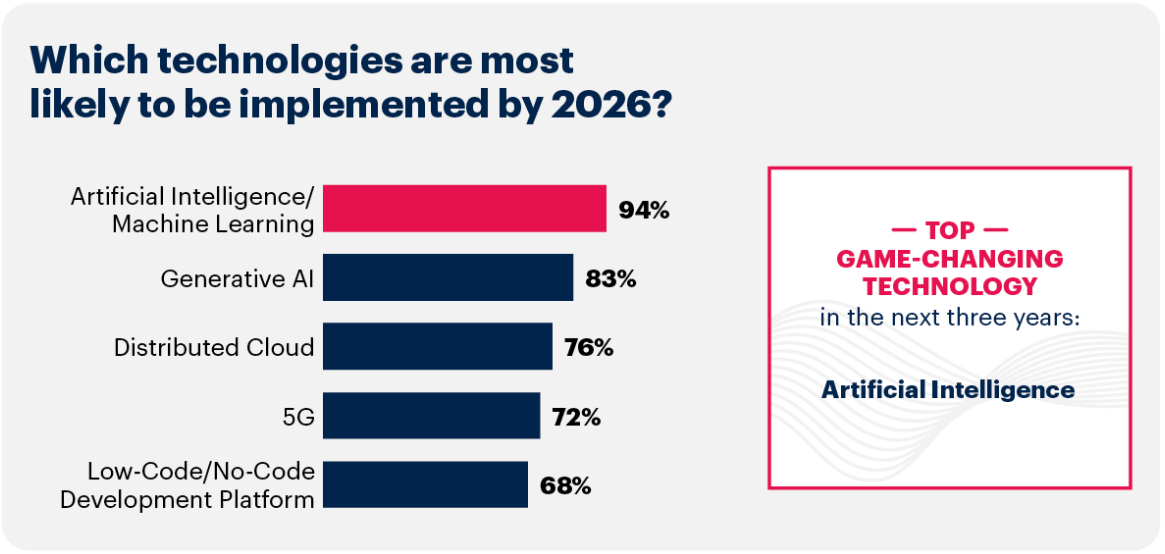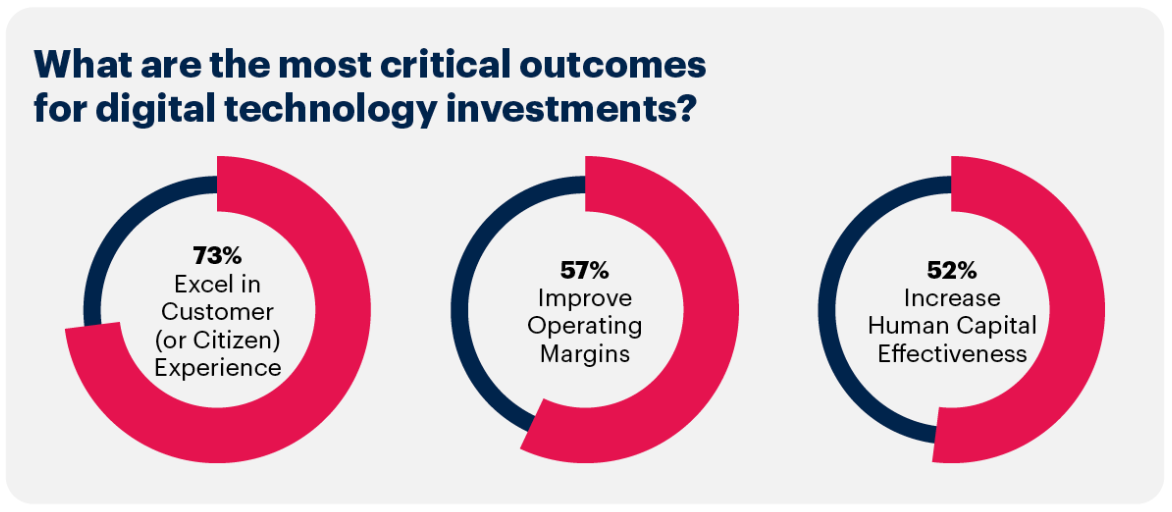The executive playbook: 10 futuristic technologies changing the healthcare industry
Technologies empowering changes that lead to better care, and longer, healthier lives for people around the world
Recent advances in the technologies and systems around artificial intelligence, machine learning, data and analytics, cloud services, and automation have expanded possibilities and challenges for healthcare and life sciences organisations.
Innovative leaders are integrating applications that accelerate drug discovery, identify novel treatments and personalise care. Let’s explore the potential of some that are already in mainstream use, and some of the most promising currently in development.
| Expert insight: | “The healthcare industry is being rewired across the entire patient journey. . . The intersection of healthcare with the digital sector is accelerating this transformation. The pandemic acted as a catalyst, making people more fluent in using digital technologies and more receptive to virtual engagement.” Lidia Fonseca, Chief Digital and Technology Officer, Pfizer |
By the numbers

Source: Infographic: 2024 Top Technology Investments and objectives in Life Sciences (October), GARTNER is a registered trademark and service mark of Gartner, Inc. and/or its affiliates in the U.S. and internationally and is used herein with permission. All rights reserved.

Source: Infographic: 2024 Top Technology Investments and objectives in Life Sciences (October), GARTNER is a registered trademark and service mark of Gartner, Inc. and/or its affiliates in the U.S. and internationally and is used herein with permission. All rights reserved.
While there are dozens of different technologies with applications in healthcare in various stages of development and use, we’re going to focus on ten of the most exciting and transformative. The tech we’ll be exploring are:
Analytics platforms for research informatics
Virtual Reality (VR) and Augmented Reality (AR) in healthcare
Augmented analytics
AI in drug discovery and early research
Genomics medicine
Generative AI in life sciences
SaaS-regulated CSP
IoT-powered virtual hospitals and telemedicine 2.0
Mobile lab apps
Digital twins in life science
Analytics platforms for research informatics
The ability to manage and analyse large amounts of data efficiently and adapt output to changing parameters is crucial in today’s information-rich healthcare industry. Use of these platforms continues to grow, and leveraging their benefits can help companies stay on top of the ever-expanding amounts of data that power their success.
Currently in use in more than 50% of healthcare organisations.
Usage: Analytics and aggregation software processes large amounts of scientific, clinical and experimental data, tests hypotheses, defines trends and predicts outcomes. Additionally, these platforms enable pattern recognition along with data mining and advanced analytics.
Benefits: Enables broader access to fast analysis of research & development (R & D) data, highlights the scientific relevance of results. Can be optimised for R & D content.
Virtual Reality (VR) and Augmented Reality (AR) in healthcare
As VR and AR hardware continues to become more accessible, the applications in healthcare are expanding. From virtual doctor visits to therapeutic treatments, VR and AR are expanding access to care and delivering some of the most exciting benefits offered by healthcare technology.
Currently in use or planned in up to 77% of healthcare organisations.
Usage: Helping patients manage long-term chronic pain and decreasing anxiety; allowing doctors performing surgery to see digital information without looking at separate screens; helping doctors assess the severity, healing status and best treatment options for wounds.
Benefits: Reduced pain and reduced time in hospital for patients; increased/easier access to consultations and treatment with virtual physical therapy/rehabilitation; virtual scenario recreations for mental health treatments.
| Nearform Expert Insight | |
|---|---|
| “In 2024, I would anticipate that a significant trend in product design for digital experiences will be the deeper integration of Augmented Reality (AR) and Virtual Reality (VR) technologies. Immersive technologies offer a more engaging and interactive user experience, going beyond traditional 2D interfaces.” Sam Sherman, VP, Design & Product, Nearform |
Augmented analytics
Automation of repetitive/duplicative tasks and the ability of software to “understand” natural language queries and output useful information are among the most transformative products of machine learning and artificial intelligence. They provide incredible savings in time and resources for healthcare organisations, and offer convenience and improved service to patients.
Currently in use in up to 50% of healthcare organisations.
Usage: Automate workflows; provide contextualised automated insights on user interfaces; couple with generative AI to enable natural language explanations and collaborative exploration.
Benefits: Democratises advanced analytics through natural language queries; allows complex analytics with low/no code; limits human biases; accelerates insights for diverse users. Additionally, conversational inputs allow non-technical staff access to information that can help with decision-making.
AI in drug discovery and early research
Traditionally, the early stages of drug discovery and research are drawn out over months and years. This means global pharmaceutical companies commit an enormous level of resources to exploring treatments that may not move on to the next stages. Applications of AI bring efficiencies that drastically improve drug candidate analysis and testing, limit the time and resources used, and potentially save more lives faster.
Currently in use in up to 20% of healthcare organisations.
Usage: Applications of machine learning, deep learning, natural language processing, generative AI and AI-enabled advanced analytics are combined. This combination increases efficiency in the drug discovery and preclinical stages of development by analysing, testing, and evaluating potential drug candidates.
Benefits: Streamlined organisation and system processes; speeding up drug development and testing; reducing some processes from years to weeks or months; drastically cutting the cost of drug development through time and resource savings.
Genomics medicine
Genomics medicine is already saving lives by accelerating analysis of genetic data to identify biomarkers that indicate a predisposition to certain illnesses, or sensitivities to treatments. The promise of this technology is driving investments in research to develop reliable and actionable patient-specific insights that can improve the quality of life for millions of people.
Currently in use in up to 20% of healthcare organisations.
Usage: Gene sequencing; analysis of genetic information to diagnose and treat patients; identification of genetic biomarkers that can predict an individual’s likely receptivity/sensitivity to a specific medicine; clinical decision support.
Benefits: Creation of targeted gene therapies for cancer and other diseases; development of patient-specific clinical diagnosis and treatments that can help heal patients faster and at lower cost; minimising potential reactions to drug treatments through genetic tests that identify sensitivities; minimising clinician errors; enabling more equitable, evidence-based treatment decisions.
| Nearform case study: Renalytix | |
|---|---|
| Company goal: | Create a deployment plan to bring an AI-enabled biomarker assessment tool to patients at scale |
| Challenges: | - Integrating Renalytix’s software with diverse systems at hospitals and healthcare providers - Ensuring clean, validated data, entered efficiently - Compliance with regulations and quality controls |
| Nearform created: | - A user-centric, cloud-based portal for clinicians - A full digital ecosystem including standards, technology stack and DevOps practices - Optimised data validation - Culture shift to an agile system that speeds up development of new features - Selection/hiring of new Renalytix team to make the program independent and sustainable |
| Impact: | - Renalytix’s service is now available to 10 million patients in the US alone - New features now delivered in 2-weekly rather than 6-monthly cycles - Cloud-based “portal” system allows clinicians to try before committing to full integration of back-end patient systems - Renalytix granted “Breakthrough Device” designation from the FDA |
| Nearform Insight: | “We deployed the solution rapidly and that led to quality-of-life improvements for patients within a couple of months. We built the doctors’ portal and received feedback that it’s very user-friendly. We also helped Renalytix to become self-sufficient by supporting our partner in building its development team and creating the processes needed to continue developing its solution.” Kurt Milam, Delivery Architect, Nearform |
Expanding access to transformative healthcare
All of the technologies we’ve covered are already empowering changes that lead to better care, and longer, healthier lives for people around the world. These technologies, and others just beginning to be developed, are also driving exponential growth in the healthcare industry. Patients are experiencing positive outcomes derived from applications of groundbreaking tech, and healthcare organisations are seeing the benefits of more streamlined and efficient research and development.
All indications point to the continued expansion of investments in transformative healthcare technologies. This investment will undoubtedly lead not only to unprecedented business success, but also to increased access to high-quality, personalised care for more people, including those who traditionally have not been able to receive it.
As enhanced care powered by technology leads to longer, healthier lives, the cycle will likely continue, feeding a positive flywheel of investment, innovation, and reinvestment.
To see the remainder of the list, download the full version of ‘The executive playbook: 10 futuristic technologies changing the healthcare industry’.
Insight, imagination and expertly engineered solutions to accelerate and sustain progress.
Contact

